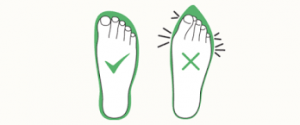
So what’s a callus, exactly?
A callus, essentially, is a build-up of skin which the body makes in response to pressure. Calluses are generally hard, can be thick, split, peeling or laminating, and often painful. Calluses, their size, shape, and location are often excellent indicators of pressure spots on the foot, whether from the bones inside, or footwear on the outside.
Where they are
Calluses can be found on hands, feet, and even the chins of professional violinists! When a callus is formed, it is in response to pressure and friction. Calluses formed on the feet are the same as calluses located anywhere else – a response to pressure and friction. When feet are bony, internal pressures create external calluses – the body has ramped up its production of skin cells, in an effort to protect itself.

Footwear choices have a direct impact on the production of calluses, as does our gait, or walking pattern. When a shoe’s toe box is very tight, calluses might form down the middle of the foot pad, or ball of the foot. The skin has been squished into the shoe, and rubs against itself with every step. Calluses on the inner edge of the big toes, around the heels, under the 5th toes, and at the ends of the small toes are very common.

Calluses can split and crack, which makes them particularly vulnerable to bacterial invasion. When calluses are very thick, prolonged walking on them can actually create ulcerations below their surface.
What to do
Calluses should be treated carefully and gently. If the callus is very thick, split, or concerning at all, a visit to your physician is in order. Visiting our St. Catharines foot clinic or chiropodist can also be an option once potential ulcerations or infections have been ruled out.
For mild calluses, regular gentle attention with a pumice stone – either natural or synthetic, followed by application of a callus cream should help. A callus cream is one that’s designed specifically for feet, and usually contains urea or lactic acid, both of which help keep the production of skin cells down. Use the pumice stone every few days, and the callus cream every night. Be careful, though, callus cream can sometimes be greasy, and make for slippery or even dangerous walking. If you get up at night, be sure to wear slippers! Slippers will also help you avoid leaving greasy foot prints on hardwood floor…
What not to do
Please resist the temptation to search the garage or workshop for tools to help with reducing calluses. The concepts are good, but tools from the garage are often oiled, and aren’t designed for use on living/human tissue. These tools, wood rasps especially, can leave minute metal particles behind in the foot.
Please also don’t look to using a razor blade or other sharp knife to reduce the callus.
And NO DREMELS! The Dremel is designed for use on wood and metal, not on human (or animal) feet.
How a foot care professional can help
Foot care nurses and chiropodists are specially educated to help with foot concerns such as calluses. These professionals are able to visualize the callus easily, and have special instruments designed for use specifically on human/living tissue. A St. Catharines callus removal is a cosmetic procedure that can quickly, easily, safely and painlessly be performed by a professional when needed.
Padding and offloading
Custom orthotics and padding for calluses can be very helpful in managing calluses. The term ‘off-loading’ essentially means to ‘take the load off’ – the bony areas of the foot. Custom orthotics may be an excellent way to help reduce the development of calluses on the sole. When shopping for orthotics, be sure you feel comfortable with the provider, and that they assess your feet and gait, and listen to your needs. Orthotics are expensive, and should never be painful to wear. Don’t be afraid to return to your orthotist if you have concerns – they want you to be happy with your purchase, too.
way to help reduce the development of calluses on the sole. When shopping for orthotics, be sure you feel comfortable with the provider, and that they assess your feet and gait, and listen to your needs. Orthotics are expensive, and should never be painful to wear. Don’t be afraid to return to your orthotist if you have concerns – they want you to be happy with your purchase, too.
A few closing thoughts.
Mild or moderate calluses can be safely managed at home, provided you can safely see and reach your feet. With calluses you’re not sure about, see your physician. If ulceration is ruled out, regular visits to a foot care nurse or chiropodist can help a great deal. Your physician may also be able to determine whether orthotics are right for you.
So don’t ignore calluses. Early detection and management will go a long way to helping you maintain healthy, happy feet.


